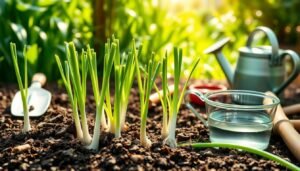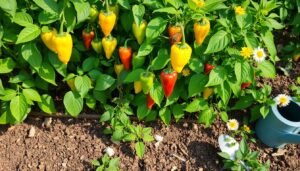Growing your own vegetables is rewarding and saves money. Families with gardens can save up to $600 on veggies. This guide will help you start a garden, from picking the right spot to choosing what to grow.
It also stresses the value of local tips, planning, and care for a bountiful harvest.
Table of Contents
Essential Planning for Your Vegetable Garden
Proper planning is key for a successful organic gardening journey. Whether you’re experienced or new to garden planting, planning well will lead to a great harvest.
Choosing the Perfect Garden Location
Start by picking the right spot for your garden. Look for a place that gets 6-8 hours of sunlight daily. This is vital for most vegetables to grow well. Also, make sure the area drains well to avoid waterlogged soil and promote healthy plants.
Determining Garden Size for Beginners
Beginners should start small. A 10×10-foot in-ground garden or a 4×4-foot or 4×8-foot raised bed is perfect. It’s big enough to try different vegetables but not too big to handle.
Understanding Your Local Climate
- Know your area’s frost dates and temperature needs to plant the right veggies at the right time.
- Get advice from your local nursery or AgriLife Extension for tips on what to plant and when.
- Use online tools like the Old Farmer’s Almanac’s Garden Planner to find the best planting times.
By planning your organic gardening carefully, you’ll have a thriving garden planting experience in your backyard garden.
Soil Preparation and Garden Bed Setup
Getting your soil ready is key for a great vegetable garden. You want a soil pH of 6.5 to 7.0 for most garden produce. Add compost or organic matter to boost soil quality and nutrients. If your soil is bad or drains poorly, think about raised beds for better growing.
Do a soil test before planting to find out what nutrients your garden needs. Use the right fertilizers to fix any issues. You want 8-12 inches of soft, friable soil for healthy vegetable roots.
- Aim for a soil pH between 6.5 and 7.0 for optimal vegetable growth.
- Incorporate compost or organic matter to improve soil quality and fertility.
- Build raised beds if soil quality is poor or drainage is a concern.
- Perform a soil test to determine specific nutrient needs and apply appropriate fertilizers.
- Aim for 8-12 inches of loose, crumbly soil to support healthy root development.
| Soil Type | Characteristics | Recommendations |
|---|---|---|
| Sandy Soil | Allows ample air to reach plant roots but drains quickly, leading to moisture and nutrient loss. | Incorporate organic matter to improve moisture and nutrient retention. |
| Clay Soil | Retains moisture well but lacks drainage and aeration for plant roots. | Amend with compost or other organic materials to improve soil structure and aeration. |
| Loam Soil | Ideal for most vegetables, providing a balance of moisture, nutrients, and aeration. | Maintain soil structure and fertility through regular compost additions. |
By getting your soil right and setting up your garden beds well, you’re on your way to a great vegetable garden harvest.
“Amending soil before planting is recommended as it is more challenging to do so after planting.”
How to Grow Vegetables on the Garden: A Complete Guide
Growing a vegetable garden is rewarding and can give your family fresh food from your backyard. It’s great for both new and experienced gardeners. This guide will help you grow a successful vegetable garden.
Selecting the Right Vegetables for Your Space
Choosing the right plants is the first step. Think about what your family likes, what’s available locally, and your area’s climate. Start with easy-to-grow veggies like lettuce, green beans, and tomatoes. Plan your garden so you have a steady supply of fresh food all season.
Proper Spacing and Layout Techniques
Spacing and layout are key for a healthy garden. Group plants by their needs for water and sunlight. Use companion planting to attract good bugs and keep pests away. This way, your plants get the air they need and won’t get too crowded.
Companion Planting Strategies
Companion planting pairs veggies, herbs, and flowers for a better garden. It boosts growth, controls pests, and keeps plants healthy. For example, marigolds can keep pests away and attract helpful insects.
| Vegetable | Ideal Sunlight | Watering Needs | Soil pH Range |
|---|---|---|---|
| Tomatoes | 6-8 hours | 1 inch per week | 6.0-6.8 |
| Lettuce | 6-8 hours | 1 inch per week | 6.0-7.0 |
| Carrots | 6-8 hours | 1 inch per week | 6.0-6.8 |
| Zucchini | 6-8 hours | 1 inch per week | 6.0-7.5 |
By following these tips, you’ll grow a great vegetable garden. It will give your family fresh, tasty food all season. Stay alert, adjust to your climate, and enjoy growing your own food.
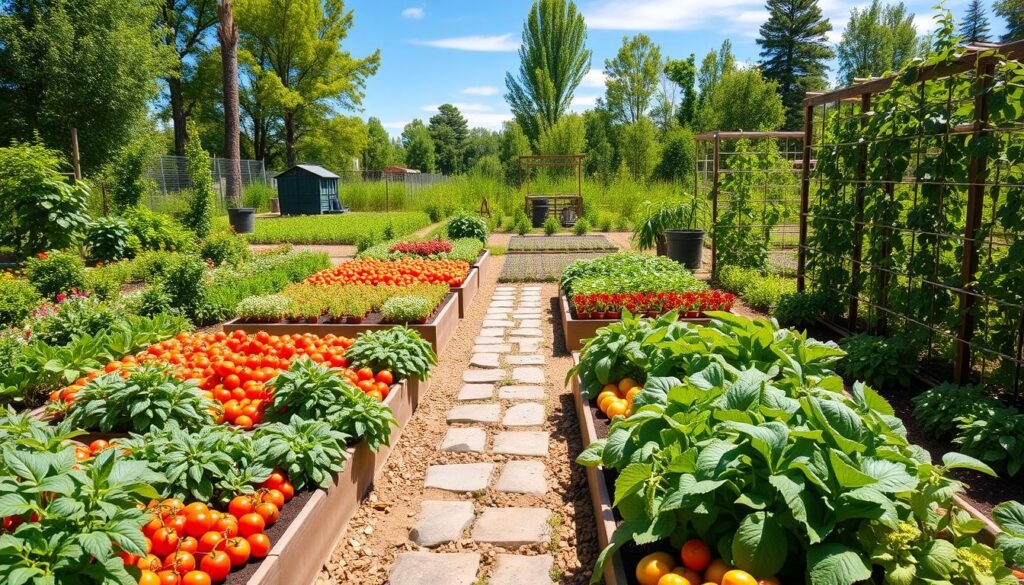
Essential Tools and Materials for Garden Success
Starting a vegetable gardening journey means getting the right tools and materials. You’ll need basics like a spade and garden fork, and specialized items too. The right equipment makes a big difference in your garden planting work.
First, get the basics. A strong spade is for digging and turning soil. A garden fork loosens the earth, and a hoe cuts weeds and makes furrows. A rake levels the soil, and a watering can or hose keeps plants watered.
| Tool | Purpose |
|---|---|
| Spade | Digging and turning soil |
| Garden Fork | Aerating and loosening soil |
| Hoe | Cutting weeds, creating furrows |
| Rake | Leveling soil |
| Watering Can/Hose | Hydrating plants |
Don’t forget a soil testing kit to check your vegetable gardening soil. Gardening gloves and a wheelbarrow are great for big garden planting jobs. For climbing plants, like tomatoes or pole beans, you’ll need trellises or cages.
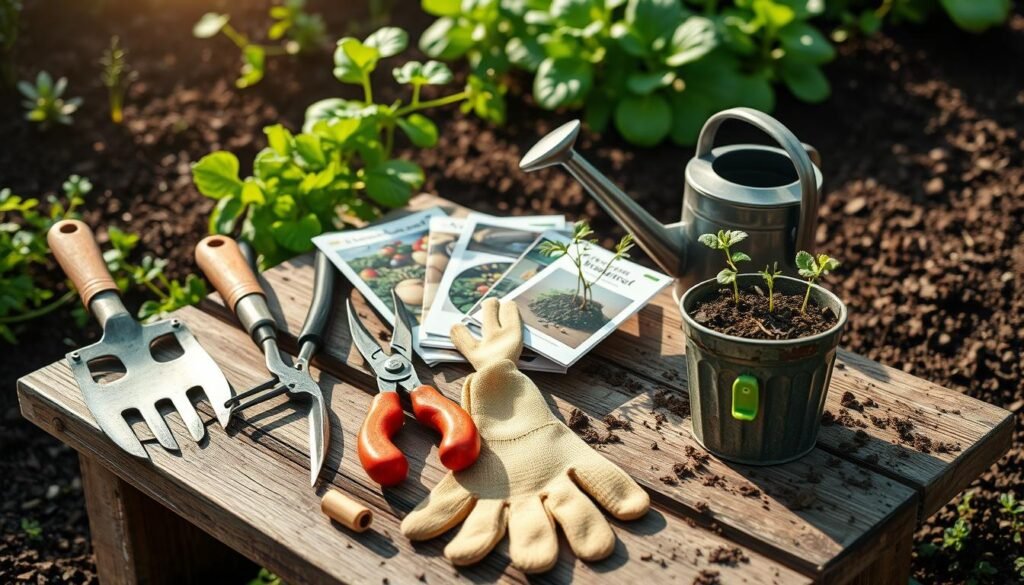
“The right tools can make all the difference in creating a thriving, bountiful vegetable garden.”
Quality vegetable gardening tools and materials are essential for success. With the right gear, you’ll enjoy a productive and fun garden planting experience.
Watering and Irrigation Methods
Keeping your garden hydrated is key for its growth and health. A good irrigation system sends water right to the roots of your plants. Drip or soaker hoses are great because they save water and prevent waste.
Setting Up Efficient Watering Systems
Creating a garden irrigation system that fits your garden’s needs saves time. Think about your soil, plants, and local weather when setting it up. This helps you water your garden just right.
Water Conservation Tips
- Use mulches like compost, straw, or grass clippings to keep soil moist and control weeds.
- Save rainwater in barrels or cisterns to help water your garden.
- Check the soil moisture often and adjust your watering based on weather and plant needs.
Moisture Management Techniques
Managing moisture is vital for healthy plants and plenty of produce. Check the soil moisture and adjust your watering schedule. Water deeply to encourage strong root growth and better water absorption.
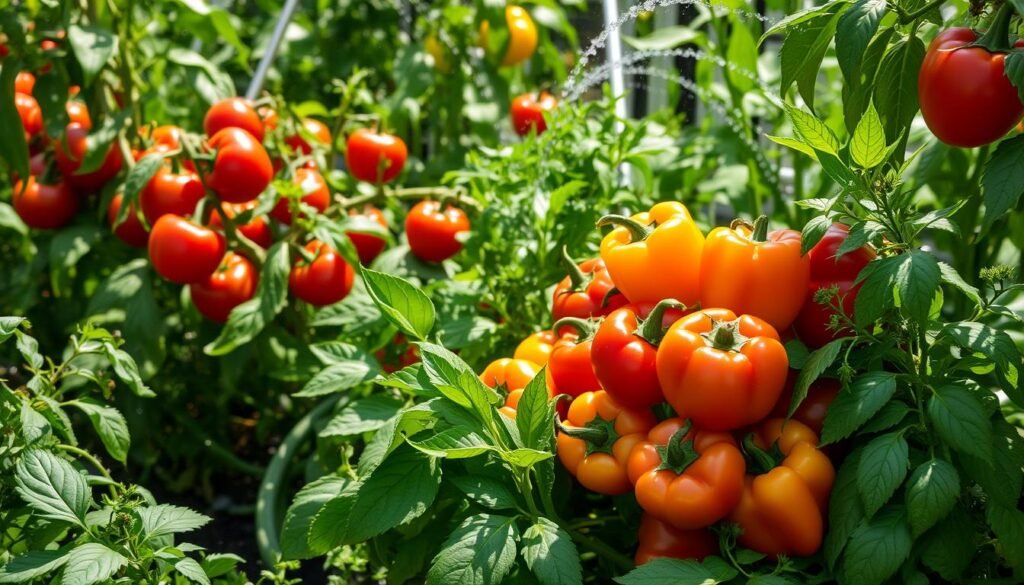
“Watering deep at the roots encourages root growth and better water conveyance to upper parts of the plant, fostering larger and healthier vegetables.”
With efficient irrigation, water-saving tips, and the right moisture, your organic garden produce will flourish. Enjoy a bountiful harvest every season.
Natural Pest Control and Plant Protection
To keep your organic garden healthy, you need a smart plan for pests. Start by picking plants that are less likely to get pests. For example, tomatoes with the VPN label are more resistant to diseases.
Keeping your garden clean and rotating crops helps a lot. Use floating row covers to keep insects away. Also, add flowers and herbs that attract good bugs, like ladybugs and lacewings. This helps keep your garden balanced and pest-free.
It’s important to check your garden often and act fast if you see pests or diseases. Early action can save your plants. Use safe, organic methods like diatomaceous earth, neem oil, or Borax to fight pests without harming the environment.
| Pest Control Method | Description |
|---|---|
| Companion Planting | Strategically planting certain herbs, flowers, and vegetables together to confuse and deter pests. |
| Organic Pesticides | Natural, plant-based insecticides and fungicides, such as neem oil, Bacillus thuringiensis (Bt), and diatomaceous earth. |
| Beneficial Insects | Attracting and encouraging the presence of predatory insects like ladybugs, lacewings, and praying mantis to control pests naturally. |
| Physical Barriers | Using floating row covers, mesh netting, or other physical barriers to protect plants from pest infestations. |
Using a mix of these organic gardening methods can keep pests away. A diverse and balanced garden is the best way to control pests for good.
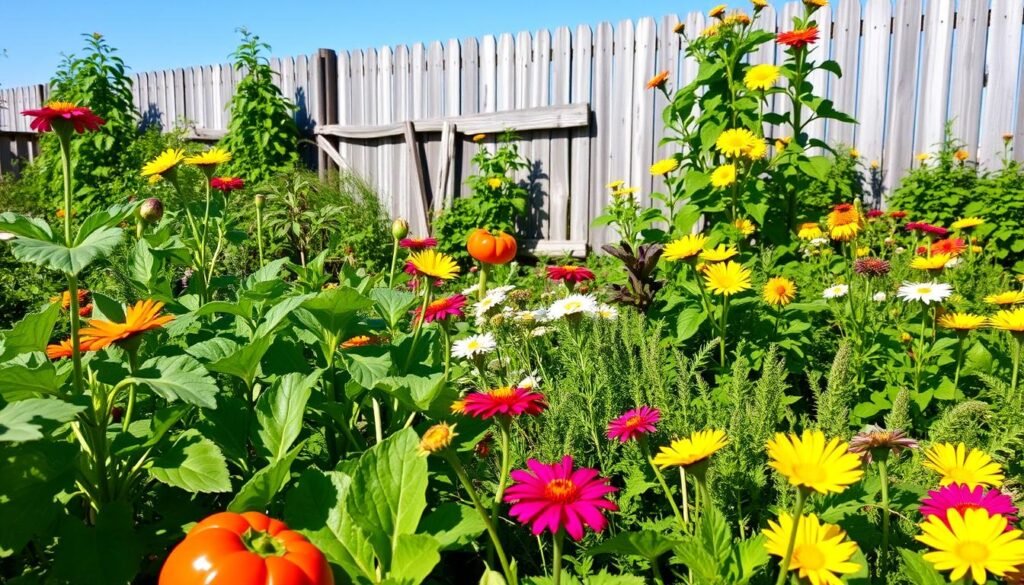
“Organic pest control begins with prevention strategies, such as using intelligent planting practices and selecting pest-free plants to avoid bringing pests and diseases into the garden.”
Garden Maintenance Throughout the Growing Season
Keeping your vegetable garden in top shape is key to a great harvest. It’s all about controlling weeds, mulching, pruning, and fertilizing. Regular care boosts your plants’ health and productivity.
Mulching and Weed Control
Begin by spreading 2-4 inches of organic mulch around your plants. It fights weeds, keeps soil moist, and improves soil health as it breaks down. Always pull out weeds fully to stop them from coming back.
Pruning and Plant Support
Pruning and supporting your plants also helps them thrive. Tall veggies like tomatoes might need staking to stay upright. Regular pruning gets rid of dead or crowded leaves, improving air and light.
Fertilizing Schedule
- Feed your plants with a balanced, organic fertilizer like Neptune’s Harvest 2-3-1 fish-seaweed blend every other week. It keeps nutrients flowing.
- Adding biostimulants like EM, sea minerals, liquid kelp, and humic acids can boost your vegetable garden‘s health and strength.
Regular garden maintenance is essential for a thriving vegetable garden. By focusing on weeding, mulching, pruning, and fertilizing, your plants will get the care they need. This ensures a bountiful harvest.
| Task | Frequency |
|---|---|
| Weeding | Several times per week |
| Removing dead/dying leaves | As needed |
| Thinning crowded seedlings | As needed |
| Suckering tomatoes | Weekly |
| Fertilizing with Neptune’s Harvest 2-3-1 | Every other week |
“Consistent vigilance and care are the hallmarks of a thriving vegetable garden.”
Harvesting and Storage Tips
Getting the most out of your home vegetable garden is important. Harvesting at the right time is key. Pick vegetables when they are at their best for flavor and texture.
For root crops, pick them when they’re big enough. For leaf crops, cut them just above the ground. This way, you get the most from your garden.
Storing your harvest right can make it last longer. Different veggies need different care. For example, tomatoes, peppers, and cucumbers like it cool and moist. On the other hand, carrots and onions can last months.
Use a root cellar for the best storage. It keeps things cool and dark, which is perfect for keeping your veggies fresh.
Storage Tips for Common Veggies
- Asparagus can last up to two weeks in cool, moist spots.
- Basil stays fresh for five days at room temperature with stems in water.
- Beans last a week, but keep them above 40°F to avoid pitting.
- Broccoli can last a month in cold, moist storage if picked right.
- Cucumbers should be stored at 55°F for a week to avoid issues.
- Eggplants only last a week and should stay above 50°F.
| Vegetable | Ideal Storage Conditions | Expected Shelf Life |
|---|---|---|
| Muskmelons | Stored correctly at 55°F | 1 week |
| Parsnips | Stored at 32°F and 95% humidity | 4 months |
| Potatoes | Cured at 50-60°F, then stored at 32-40°F | 6 months |
Knowing how to store your garden harvest can make it last longer. With the right methods, you can enjoy your garden’s bounty for weeks or even months.
Conclusion
Growing your own vegetables at home is rewarding and fulfilling. By growing vegetables on the garden, you get fresh, nutritious food. You also help the environment and improve your health.
Start small and learn as you go. Plan your garden and take care of your plants. This way, you can enjoy the benefits of your hard work.
Using the right gardening techniques is key. Try companion planting and crop rotation. Also, use natural pest control and efficient watering. With effort, you’ll enjoy the fruits of your labor.
Remember, starting small and learning as you go is important. Growing your own food improves your health and helps the planet. Enjoy the journey and the fresh produce it brings.


